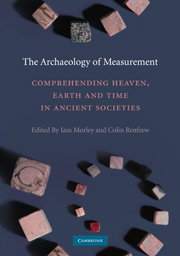Book contents
- Frontmatter
- Contents
- List of figures and tables
- List of contributors
- Acknowledgements
- The Archaeology of Measurement
- Introduction: Measure: Towards the construction of our world
- SECTION I NUMBER: COUNTING, MATHEMATICS AND MEASURE
- SECTION II MATERIALISING THE ECONOMY
- SECTION III DIMENSIONS AND BELIEF
- 10 Architectural measurements in the Indus cities: The case study of Mohenjo-Daro
- 11 Teotihuacan city layout as a cosmogram: Preliminary results of the 2007 Measurement Unit Study
- 12 Aztec dimensions of holiness
- 13 Establishing direction in early Egyptian burials and monumental architecture: Measurement and the spatial link with the ‘other’
- SECTION IV CALENDAR AND COSMOLOGY
- SECTION V THE SPIRITUALITY OF MEASURE
- Index
- References
10 - Architectural measurements in the Indus cities: The case study of Mohenjo-Daro
Published online by Cambridge University Press: 05 June 2012
- Frontmatter
- Contents
- List of figures and tables
- List of contributors
- Acknowledgements
- The Archaeology of Measurement
- Introduction: Measure: Towards the construction of our world
- SECTION I NUMBER: COUNTING, MATHEMATICS AND MEASURE
- SECTION II MATERIALISING THE ECONOMY
- SECTION III DIMENSIONS AND BELIEF
- 10 Architectural measurements in the Indus cities: The case study of Mohenjo-Daro
- 11 Teotihuacan city layout as a cosmogram: Preliminary results of the 2007 Measurement Unit Study
- 12 Aztec dimensions of holiness
- 13 Establishing direction in early Egyptian burials and monumental architecture: Measurement and the spatial link with the ‘other’
- SECTION IV CALENDAR AND COSMOLOGY
- SECTION V THE SPIRITUALITY OF MEASURE
- Index
- References
Summary
To date, the major corpus of published information on Indus architecture is still that from the early excavations in the 1920s and early 1930s of Mohenjo-Daro (Mackay 1938; Marshall 1931). With the later excavations by Wheeler (Wheeler 1953) and Dales (Dales & Kenoyer 1986) no major data of physical remains could be added, except the Granary and some fortification in the citadel area reported by Wheeler (excavated in 1947 and 1950, respectively), and a low-lying area with a slope situated at the western edge of the ‘lower City’, west of HR area (UPM area) (see Figure 10.1), excavated in 1964 by George Dales. In terms of the conception of the interpretation of the Indus Valley Civilization, both excavations were important, as Mortimer Wheeler discovered the “centralized economic Priest-King system” of this civilization, represented by the ‘State Granary’. He also foresaw the great importance of his deep dig (1950), which clearly indicated a gigantic substructure of the citadel. This surrounded, at least, the whole western part of the settlement, as was demonstrated later by the German Research Project at Mohenjo-Daro (1982–84). Today we know that the visible part of Mohenjo-Daro, covering approximately 100 hectares, only represents the ‘tip of the iceberg’; in 1989, within the UNESCO Campaign programme for its protection against the Indus floods and for the stabilisation of the Indus River banks, large spurs were built into the Indus bed.
- Type
- Chapter
- Information
- The Archaeology of MeasurementComprehending Heaven, Earth and Time in Ancient Societies, pp. 125 - 129Publisher: Cambridge University PressPrint publication year: 2010



